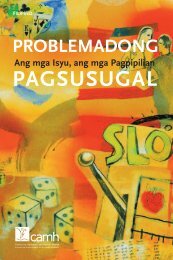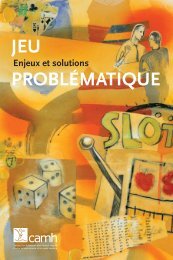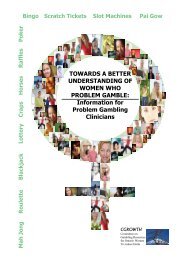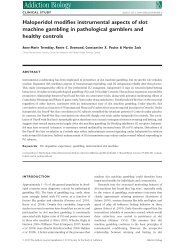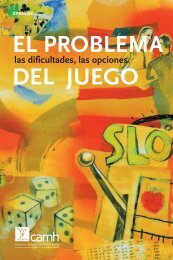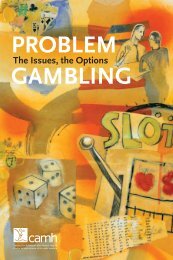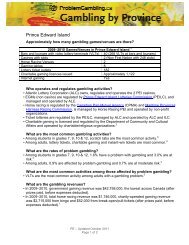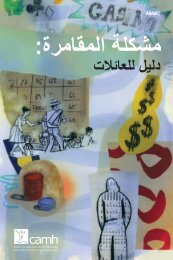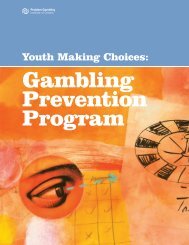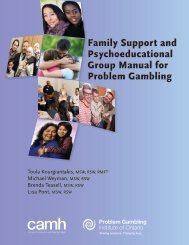Announcement Brochure - ProblemGambling.ca
Announcement Brochure - ProblemGambling.ca
Announcement Brochure - ProblemGambling.ca
- No tags were found...
Create successful ePaper yourself
Turn your PDF publications into a flip-book with our unique Google optimized e-Paper software.
IntroducingThe <strong>ProblemGambling</strong> Instituteof Ontario1
Gambling in Canada: A Growth IndustryProvincial and territorial governmentsin Canada own, operate, regulateand receive revenue from legal formsof gambling.YearNet revenue from government-run lotteries, video lotteryterminals, <strong>ca</strong>sinos and slot machines not in <strong>ca</strong>sinos1992 $2.73 billion 12008 $13.67 billion 1The largest “entertainment” industryin the country, gambling now generatesapproximately as much revenue asmovies, television, recorded music andprofessional sports combined. 2Gambling in Ontario: The PlayersApproximately 60% of Ontario adults gamble, usually with lottery tickets. 3The majority of people who gamble do so without problems. 3Problem Gambling in Ontario:The NumbersOver 300,000 adults in Ontario have moderate to severe gambling problems. 3The rate among teens is more than double that of adults. 3One in 10 people report being negatively affected by someone else’s gambling. 3People with gambling problems are also more likely to be affected bymental health problems, especially substance-use disorders, mood disorders,ADHD and personality disorders. 42
Advancing OurWork in <strong>ProblemGambling</strong>Fostering a Climate of Scientific Discovery,Innovation and Information SharingAs CAMH’s new CEO, I am delighted to announce the formation of theProblem Gambling Institute of Ontario (PGIO). The PGIO signals CAMH’scommitment to advancing our work in problem gambling by formallyintegrating the work of our researchers, clinicians and staff responsible foredu<strong>ca</strong>tional and community resources.The PGIO will allow us to work more closely together; not only internally, butwith our community partners. Our experience at CAMH shows that collaborationleads to new scientific discoveries, resulting in better treatments and preventionprograms that directly improve the health of our community.The PGIO fits with our mission as an a<strong>ca</strong>demic health sciences centre. OurUniversity of Toronto–affiliated researchers work with our clinicians to developevidence-based <strong>ca</strong>re. Just as important is our role in sharing knowledge in theform of tools, training resources and effective prevention programs.The PGIO <strong>ca</strong>n serve as a hub resource by offering CAMH’s diverse expertise inmental health and addiction. We are committed to helping the treatment systemincrease its <strong>ca</strong>pacity to provide <strong>ca</strong>re to people with complex gambling problems.As one example, people living in communities outside of a big city sometimesstruggle for access to the right kind of <strong>ca</strong>re. Our psychiatrists and otherspecialist clinicians, who have expertise both in gambling problems and othermental health and addiction problems, <strong>ca</strong>n help by providing consultation tothe health providers in those communities where there are limited resources.But this is not a one-way exchange. Collaborating with other lo<strong>ca</strong>l andinternational organizations working to address problematic gambling meansthe work we do is better and more effective. I look forward to meeting more ofyou as we work together to help all people with gambling problems and theirfamily members. Together, we <strong>ca</strong>n develop solutions for problem gambling thatwill help change people’s lives.Dr. Catherine Zahn, President and CEOCentre for Addiction and Mental Health3
“Bringing together CAMH’s diverseresources into one Institute <strong>ca</strong>n make thisinitiative in problem gambling a model.”Dr. Michael BagbyDr. michael bagby, Director of Clini<strong>ca</strong>l research, CAMH (LEFT)Wayne Skinner, Deputy Clini<strong>ca</strong>l Director, Addictions Program, CAMH (RIGHT)4
CollaborativeLeadershipMichael Bagby and Wayne Skinneron the PGIO at CAMHDr. Michael Bagby, CAMH’s director of clini<strong>ca</strong>l research, focuses some of his ownhighly regarded work in personality on problem gambling. He has seen first-handthe benefits of collaboration and integration in researching addiction and mentalhealth problems.“This is the way of the future,” he says about the PGIO. “Bringing togetherCAMH’s diverse resources into one Institute <strong>ca</strong>n make this initiative in problemgambling a model. It underlines CAMH’s collective interest in developingknowledge that makes a difference in reducing the harms <strong>ca</strong>used by problemgambling.”Wayne Skinner, deputy clini<strong>ca</strong>l director for CAMH’s Addictions Program,oversees the treatment services and the team responsible for edu<strong>ca</strong>tion andresource development. He points to the strong foundation of collaboration thathas been built up over more than 10 years of working together.“The set of informal relationships that exist among researchers, cliniciansand edu<strong>ca</strong>tors working in the problem gambling area makes the <strong>ca</strong>se for takingthis next step of formally organizing our diverse resources into an integratedidentity,” Skinner says. He noted that an essential part of these changes is toenhance partnerships, but not just within CAMH; in fact, CAMH through thePGIO is seeking to further its community connections and external partnerships.Says Skinner, “It’s all about developing really useful knowledge that <strong>ca</strong>n be usedin the prevention and treatment of gambling problems in Ontario and beyond.Working together is the best way to do that.”Bagby and Skinner see leadership in the PGIO as a collaborative process,which includes Robert Murray, head of the team responsible for edu<strong>ca</strong>tional andcommunity resources; Nina Littman-Sharp, manager of the treatment service;Barney Savage, the director of CAMH’s public policy unit; and the scientists whowork full time on problem gambling: Drs. Tony Toneatto, Nigel Turner, DanielaLobo and Martin Zack.“We have remarkable people working in this area. PGIO gives us a way, throughcollaborations and partnerships, to develop knowledge and practices that have areal impact on the health of Ontarians,” Bagby says.5
PGIO Mission:Sharing Solutions.Changing Lives.The Problem Gambling Institute of Ontario bringstreatment professionals and leading researchers togetherwith experts in communi<strong>ca</strong>ting and sharing knowledge.Their focus is on collaboratively developing, modellingand sharing evidence-based solutions to gamblingrelatedproblems, within Ontario and around the world.6
PGIO: Buildingon our StrengthsClini<strong>ca</strong>lThe PGIO has the largest specialized gambling treatment program in Ontario.Those in the Toronto area who are affected by their own problematic gamblingor that of a family member <strong>ca</strong>n participate in clini<strong>ca</strong>l programs that have beendesigned with their needs in mind. Our program includes specialized servicesfor women, youth, older adults and ethno-cultural communities. In partnershipwith other organizations, we fund and train practitioners to provide problemgambling treatment and outreach in 17 languages. Psychiatric and other clini<strong>ca</strong>lconsultation is available to treatment professionals who have clients withcomplex gambling problems, including other mental health and addiction issues.ResearchCAMH is Canada’s largest mental health and addictions research facility, with100 full-time scientists and 300 research staff working to better understandmental illness and substance-use disorders; to improve diagnosis, preventionand intervention; and to develop public policies. Approximately half of thefunding provided by the Ontario Problem Gambling Research Centre has beenawarded to our problem gambling researchers. Areas of research investigationhave included the genetics of problem gambling behaviour, potentialpharmacologi<strong>ca</strong>l treatments and evaluations of different treatment approaches,including cognitive therapy, acupuncture, telephone counselling and mutualaidapproaches. Our researchers have also developed screening, assessment,treatment and relapse-prevention resources.Edu<strong>ca</strong>tion and Community ResourcesTraining and support is provided to Ontario’s specialized problem gamblingtreatment system and allied professionals, including financial counsellors,correctional workers, addiction and mental health specialists, EAP providers,edu<strong>ca</strong>tors and ethno-cultural workers. Specialized training and support is alsoprovided for all employees of the Ontario Lottery and Gaming Corporation(OLG), the provincial agency operating and managing province-wide lotteries,<strong>ca</strong>sinos and slots facilities at horse racing tracks. Available resources forpeople affected by problem gambling, their families and helping professionalsinclude a comprehensive treatment manual, a multi-faceted package to supportcommunity-based awareness initiatives, a series of information guides and<strong>ProblemGambling</strong>.<strong>ca</strong>, a comprehensive, bilingual website for information andresources on problem gambling.7
Collaborations leadto new services…Robert MurrayManager of PGIO’sEdu<strong>ca</strong>tion andCommunity ResourcesHelping toSave LivesDeveloping Evidence-BasedResidential Treatment“Our experience at CAMHshows that collaboration leadsto new scientific discoveries,resulting in better treatmentsand prevention programsthat directly improve thehealth of our community.”Dr. Catherine Zahn,President and CEO“The residential treatment program saved my life,”is a comment that Charlie Mos<strong>ca</strong>tello, a problem gamblingcounsellor with the Windsor Regional Problem GamblingService, frequently hears from clients of the three-weekprogram. Mos<strong>ca</strong>tello cites the example of one client who had losthis job and marriage due to his gambling problems and had adebt of over $100,000. He was so desperate about his situationthat he was seriously thinking about suicide before entering theprogram. Mos<strong>ca</strong>tello says that suicidal thoughts are actuallyquite common among clients before they enter residential <strong>ca</strong>re.Some people with gambling problems, especially those withother health and social problems, need more intensive help than<strong>ca</strong>n be offered on an outpatient basis. To address this need,the Ontario Ministry of Health and Long-Term Care contractedCAMH to manage the development of a residential and daytreatmentservices pilot project. The Windsor program was oneof four organizations from across the province selected through8
an RFP process, along with ADAPT in Halton/Peel; the St. Joseph’s Care Group, SisterMargaret Smith Centre in Thunder Bay; andThe Jean Tweed Centre in Toronto.Robert Murray, manager of PGIO’s edu<strong>ca</strong>tionand community resources division, led theprocess and coordinated the steering committeeand training. He says that one excitingaspect of this project was the opportunityto collaborate with Dr. Tony Toneatto, aCAMH clini<strong>ca</strong>l researcher, who developed anevaluation protocol that would not only helpensure quality services but also determine anevidence-based model for residential treatment.Mos<strong>ca</strong>tello agrees the evaluation was animportant component. “The research allowedus to evaluate the program’s impact and tostrengthen program areas to better serve theclients and improve its overall effectiveness,”he says. In the future, he suggests, “the PGIOcould provide a central knowledge base of bestpracticeresearch for all treatment providersto access along with the provision oftraining for counsellors in order to ensure astandardized level of edu<strong>ca</strong>tion and <strong>ca</strong>re.”Murray says that this collaboration showsthe type of possibilities that the PGIO opens up.“The PGIO will see knowledge generation moreeffectively and rapidly translated into concreteresources and services that ultimately lead tobetter responses for people affected by problemgambling,” he says.9
…to shortening thegap between discoveryand appli<strong>ca</strong>tion…Nina Littman-SharpManager of PGIO’sClini<strong>ca</strong>l ProgramsA WinningApproachClients Gain from Researchinto Clini<strong>ca</strong>l FAQs“clients often want to understand why some people <strong>ca</strong>nwalk into a <strong>ca</strong>sino, gamble and walk out, while they themselvesdevelop a problem,” says Nina Littman-Sharp, manager ofPGIO’s clini<strong>ca</strong>l programs for problem gambling. “Large winsare a risk for many people, but not for all,” she says. When Dr.Nigel Turner, a CAMH social-epidemiologi<strong>ca</strong>l research scientist,sat down with Nina and her staff to brainstorm potentialareas for research investigation, she suggested he look at thisquestion. Intrigued, Turner proceeded to conduct a large studyon winning and other risk and protective factors. 5 “I found thestudy results very helpful in understanding, and helping clientsto understand, risk factors for developing problems, what makesthem most vulnerable to relapse, and what they might do tomake relapse less likely,” Littman-Sharp says.Turner says that clinicians are quite aware of the erroneousbeliefs involved with problem gambling. This research further10
enabled clini<strong>ca</strong>l staff to help clients understandthat when they have a big win early on intheir gambling experience, new or strongerassociations <strong>ca</strong>n occur in the brain that <strong>ca</strong>nlead to problem gambling behaviour. Theresearch also provided some direction as tohow to help clients unlearn these associations.Littman-Sharp says that normally,researchers come up with their own questionsand clinicians only hear about the studiesafter the fact. Being consulted early in theprocess allows counsellors to be involved withdeveloping research questions, suggestingpeople to talk to and recommendingprocedures. “Working together and sharingour expertise leads to better research that’smore useful to clinicians and to clients,” shesays. She is excited that the PGIO will providemore opportunities for not only cliniciansworking internally, but also other treatmentprofessionals in the community to help defineresearch questions.Turner agrees that working with clini<strong>ca</strong>lstaff shortens the gap between discoveringthe information and its appli<strong>ca</strong>tion. “The flowfrom dialoguing with clinicians through to aresearch project into prevention material isfacilitated by starting out with real-world needsfrom clinicians working with clients, and alsofrom the real-world gambling experiences ofthe clients themselves,” he says. He believesthat the PGIO, as a dedi<strong>ca</strong>ted problem gamblinginstitute within CAMH, will facilitate greatercollaboration between researchers andclinicians, helping to ensure that scientifi<strong>ca</strong>llyvalidated treatment interventions andprograms are integrated into practice.11
…and to treatmentsof the future.Martin Zack, PhDScientistClini<strong>ca</strong>l NeuroscienceSectionThe NextFrontierMedi<strong>ca</strong>tions Matched to ProblemGamblers’ Unique ProfilesDr. martin zack, a <strong>ca</strong>mh neuroscientist, has conductedpreliminary research that he hopes will one day not only leadto specific medi<strong>ca</strong>tions to treat problem gambling, but will alsohelp determine which patients would most benefit from them.Patient–treatment matching may not only maximize therapeuticresponse; it could also prevent situations in which a medi<strong>ca</strong>tionintensifies existing symptoms. Zack and his colleaguesconducted an experiment in which they gave a single dose ofmodafinil, a medi<strong>ca</strong>tion used to treat co<strong>ca</strong>ine addiction, to nontreatment–seekingpathologi<strong>ca</strong>l gamblers. They found that thedrug was effective in reducing gambling urges among gamblerswho scored high on the impulsivity s<strong>ca</strong>le (while gambling isan impulse-control disorder, people differ as to their degree ofimpulsivity), while people who scored low on the s<strong>ca</strong>le wereactually more inclined to gamble. Such bidirectional effectssuggest that the drug has hit on an important brain mechanism12
elated to gambling. At the same time,they underscore the need for <strong>ca</strong>ution whenprescribing these agents. Zack says the nextstep is to repli<strong>ca</strong>te the study and to isolate thechemi<strong>ca</strong>ls involved in modafinil’s effects.Dr. Daniela Lobo, a CAMH psychiatrist whohas been treating pathologi<strong>ca</strong>l gamblers for10 years and a genetics researcher, has beencollaborating on Zack’s work from a geneticsperspective. She believes the gamblers’ variedresponse to modafinil depending on their levelof impulsivity is a result of the reward systemfunctioning differently amongst them, which<strong>ca</strong>n be linked to genetic differences. Lobosays that some genes in the dopamine systemhave been associated with problem gambling.Understanding more about impulsivity inproblem gamblers, she says, will also helpidentify people at higher risk.Zack and Lobo believe the PGIO will facilitatefurther research of this type, ultimatelyincluding clini<strong>ca</strong>l trials to test pharmacologi<strong>ca</strong>ltreatments for problem gambling. Lobo, asa clinician and scientist, sees the PGIO asuniquely offering the type of environmentwhere researchers and clinicians <strong>ca</strong>n cometogether. CAMH’s focus on co-occurring mentalhealth and addiction disorders also increasesher clini<strong>ca</strong>l abilities and allows her to share thisknowledge with other professionals.Lobo is pleased that the PGIO will raiseawareness of problem gambling among medi<strong>ca</strong>lprofessionals. She says, “Years ago, no familydoctor or community doctor would really askabout addictions. Today there are many peoplewho don’t tell their doctors that they have aproblem with gambling be<strong>ca</strong>use they are tooashamed, and on the other hand, professionalsdon’t ask either be<strong>ca</strong>use they don’t think it’s acommon problem. As psychiatrists and otherhealth professionals begin to understand moreabout the connection between addiction, mentalhealth and problem gambling, this will raiseawareness about the importance of screeningand recognizing when a person has a problemwith gambling.”13
Help for PeopleAffected byProblem GamblingSelected Resources<strong>ProblemGambling</strong>.<strong>ca</strong> – a multimedia, bilingual website providing opportunitiesfor online collaboration, screening tools, training and resources for professionalsand people who experience gambling problems and their family members.The Inventory of Gambling Situations – a 63-item self-report questionnairethat measures a client’s risk for excessive gambling in a variety of emotionalsituations. Therapists <strong>ca</strong>n use the tool to develop a profile of a client’s gamblingbehaviours and an individualized treatment plan (available at problemgambling.<strong>ca</strong>).Journal of Gambling Issues – a peer-reviewed, scientific journal inpubli<strong>ca</strong>tion since 2000, the JGI has published many of the problem gamblingresearch field’s most influential articles, service profiles of innovative treatmentcentres, first-person accounts of gambling experiences and reviews (availableat www.<strong>ca</strong>mh.net/egambling).Problem Gambling Handbooks – a series of guides for allied professionals,financial counsellors, people who may be experiencing problems and familymembers with tips on how to determine if someone is having a problem and howto obtain help (available at problemgambling.<strong>ca</strong>).14
PGIO:Future DirectionsDeveloping InitiativesSelf-help and other Internet resources: Screening tools, self-helpmanuals and online access to support are currently being developed for peoplewho experience problem gambling and their families.Policy development: PGIO researchers, in collaboration with communitypartners, will compile the evidence that makes the <strong>ca</strong>se for public policies andinterventions to reduce the harms resulting from problem gambling. Forthe past de<strong>ca</strong>de, CAMH research has been used in this way to influence drugand alcohol policy.15
For further information about the PGIO:www.problemgambling.<strong>ca</strong>Mailing address:Problem Gambling Institute of Ontario33 Russell StreetToronto, OntarioM5S 2S1For help or information about treatment:Call 416 535-8501, ext. 3912; ask for the Intake CoordinatorFax: 416 599-1324E-mail: gambling@<strong>ca</strong>mh.netFor information about our edu<strong>ca</strong>tion and community resources:Call 416 535-8501, ext. 4253Fax: 416 260-4185E-mail: PGEdu<strong>ca</strong>tion@<strong>ca</strong>mh.netDesign: Hambly & Woolley Inc. Photography: Paul Orenstein Writing: Creative FusionFor information about problem gambling research:Call 416 535-8501, ext. 6939Fax: 416 979-6821E-mail: Michael_Bagby@<strong>ca</strong>mh.netTo contact the CAMH switchboard:Call 416 535-8501Visit the CAMH website at www.<strong>ca</strong>mh.netVersion française disponible à www.problemgambling.<strong>ca</strong>/fr1 Statistics Canada. (2009, July). Perspectives on labour and income: Gambling. Available: http://www.stat<strong>ca</strong>n.gc.<strong>ca</strong>/pub/75-001-x/topics-sujets/pdf/topics-sujets/gambling-jeuxdehasard-2009-eng.pdf. Accessed January 15, 2009.2. Rutsey, B. (2009). Four years and counting. Canadian Gaming Business: The State of Gaming in Canada, 4(3), 6.3. Wiebe, J., Mun, P. & Kauffman, N. (2006). Gambling and Problem Gambling in Ontario 2005. Available: http://responsiblegambling.org/articles/gambling_and_problem_gambling_in_ontario_2005.pdf. Accessed January 15, 2009.4. Toneatto, T. & Miller, G. (2004). Assessing and treating problem gambling: Empiri<strong>ca</strong>l status and promising trends.Canadian Journal of Psychiatry, 49, 517–525.5. Turner, N., Littman-Sharp, N., Zangeneh, M. & Spence, W. (2006). The experience of gambling and its role in problem gambling.International Gambling Studies, 6, 237–266.Final report, “Winners: Why do some people develop gambling problems while others do not?”, is available on the OntarioProblem Gambling Research Centre site at www.gamblingresearch.org.




